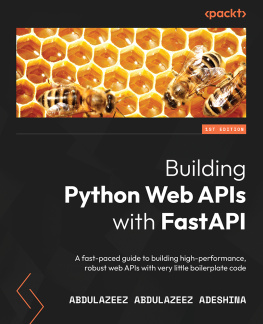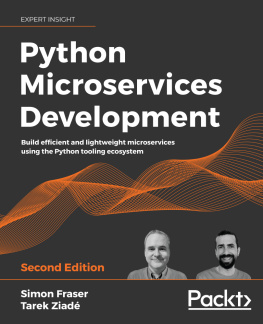Sherwin John Tragura - Building Python Microservices with FastAPI: Build secure, scalable, and structured Python microservices from design concepts to infrastructure
Here you can read online Sherwin John Tragura - Building Python Microservices with FastAPI: Build secure, scalable, and structured Python microservices from design concepts to infrastructure full text of the book (entire story) in english for free. Download pdf and epub, get meaning, cover and reviews about this ebook. year: 2022, publisher: Packt Publishing - ebooks Account, genre: Computer. Description of the work, (preface) as well as reviews are available. Best literature library LitArk.com created for fans of good reading and offers a wide selection of genres:
Romance novel
Science fiction
Adventure
Detective
Science
History
Home and family
Prose
Art
Politics
Computer
Non-fiction
Religion
Business
Children
Humor
Choose a favorite category and find really read worthwhile books. Enjoy immersion in the world of imagination, feel the emotions of the characters or learn something new for yourself, make an fascinating discovery.
- Book:Building Python Microservices with FastAPI: Build secure, scalable, and structured Python microservices from design concepts to infrastructure
- Author:
- Publisher:Packt Publishing - ebooks Account
- Genre:
- Year:2022
- Rating:3 / 5
- Favourites:Add to favourites
- Your mark:
Building Python Microservices with FastAPI: Build secure, scalable, and structured Python microservices from design concepts to infrastructure: summary, description and annotation
We offer to read an annotation, description, summary or preface (depends on what the author of the book "Building Python Microservices with FastAPI: Build secure, scalable, and structured Python microservices from design concepts to infrastructure" wrote himself). If you haven't found the necessary information about the book — write in the comments, we will try to find it.
Discover the secrets of building Python microservices using the FastAPI framework
Key Features- Provides a reference that contains definitions, illustrations, comparative analysis, and the implementation of real-world apps
- Covers concepts, core details, and advanced integration and design-related topics
- Imparts context, app templates, suggestions, and insights that are helpful to actual projects
FastAPI is an ASGI-based (Asynchronous Server Gateway Interface) framework that can help build modern, manageable, and fast microservices. Because of its asynchronous core platform, this ASGI-based framework provides the best option when it comes to performance, reliability, and scalability over WSGI-based Django and Flask. When working with Python, Flask, and Django microservices, youll be able to put your knowledge to work with this practical guide to building seamlessly manageable and fast microservices.
Youll begin by understanding the background of FastAPI and learning how to install, configure, and use FastAPI to decompose business units. Youll explore a unique and asynchronous REST API framework that can provide a better option when it comes to building microservices. Next, the book will guide you on how to apply and translate microservices design patterns in building various microservices applications and RESTful APIs using the FastAPI framework.
By the end of this microservices book, youll be able to learn, build, deploy, test, and experiment with microservices and their components using the FastAPI framework.
What you will learn- Understand, orient, and implement REST APIs using the basic components of the FastAPI framework
- Build asynchronous as well as synchronous REST services using the built-in pydantic module and asyncio support
- Create small-scale and large-scale microservices applications using features supported by FastAPI
- Build event-driven and message-driven applications using the framework
- Create an asynchronous and synchronous data layer with both relational and NoSQL databases
- Perform numerical and symbolic computations with FastAPI
This book is for Python web developers, advanced Python users, and backend developers using Flask or Django who want to learn how to use the FastAPI framework to implement microservices. Readers familiar with the REST API and microservices will also benefit from this book. Some parts of the book contain general concepts, processes, and instructions that intermediate-level developers and Python enthusiasts can relate to as well.
Table of Contents- Setting up FastAPI for Starters
- Exploring the Core Components
- Using Dependency Injection to Manage Objects
- Building the Microservices Application
- Connecting to a Relational Database
- Using MongoDB to Build NoSQL Data Layer
- Securing the Microservice Application
- Asynchronous, Event-Driven, and Message-Driven Programming
- Managing, Monitoring and Testing the Microservices
- Solving Numerical and Symbolic Problems
- Using Docker, Kubernetes, AWS, NGINX and Other Infrastructure Solutions
Sherwin John Tragura: author's other books
Who wrote Building Python Microservices with FastAPI: Build secure, scalable, and structured Python microservices from design concepts to infrastructure? Find out the surname, the name of the author of the book and a list of all author's works by series.








